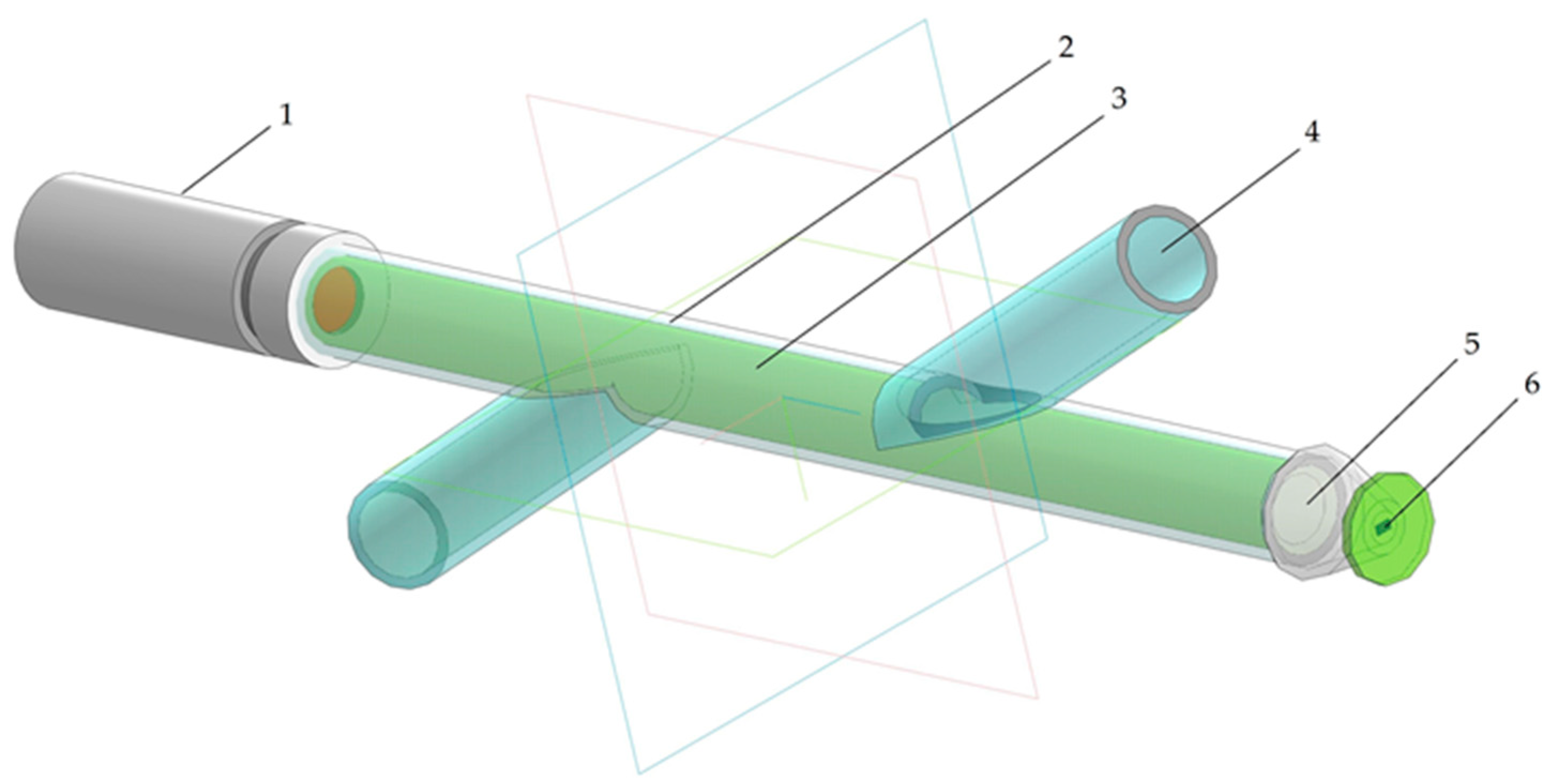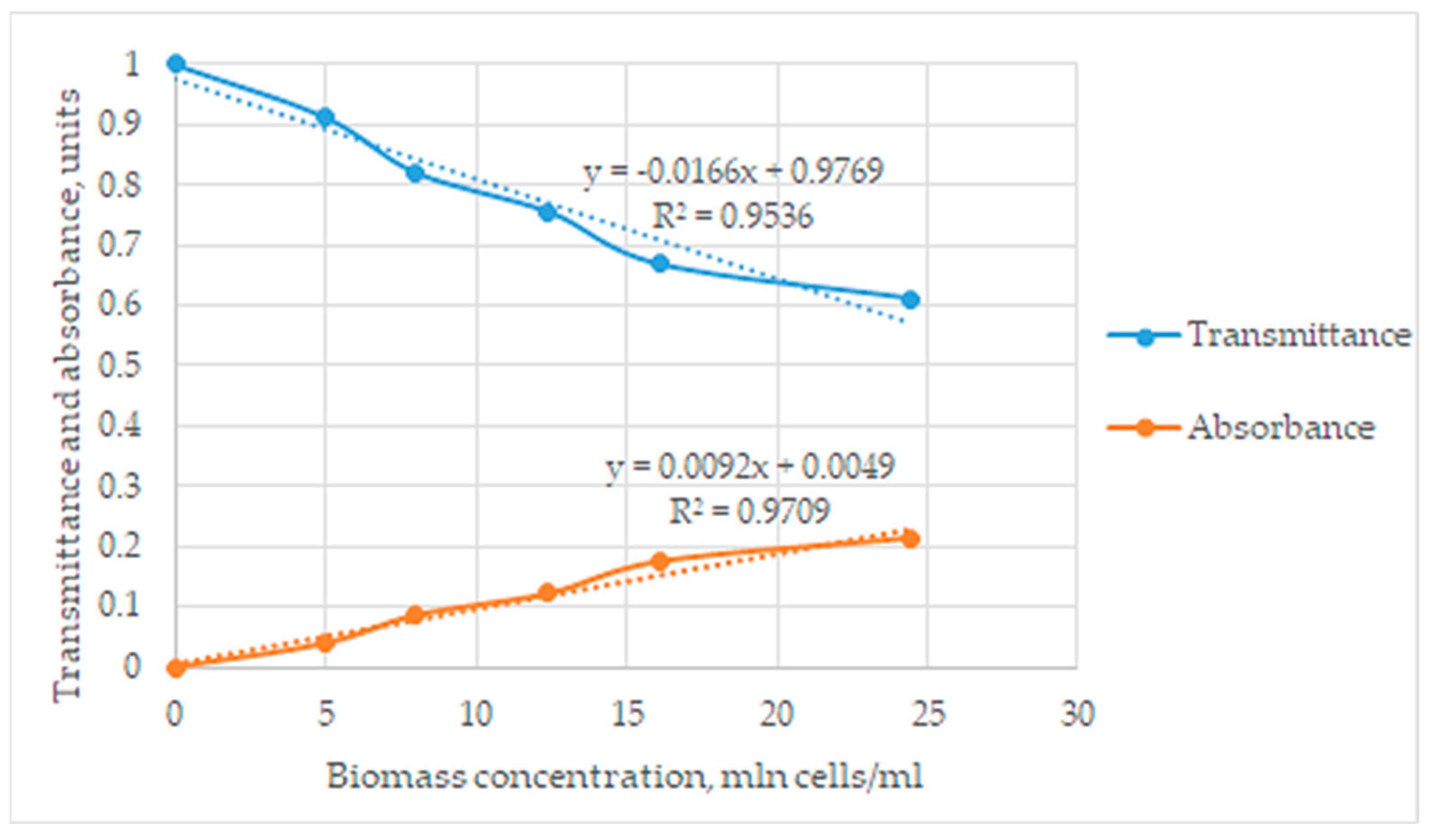A Flow Photometric Cell for In-Line Analysis of the Biomass Content of the Microalgae Nannochloropsis sp. †
Abstract
:1. Introduction
2. Materials and Methods
3. Results and Discussion
4. Conclusions
Author Contributions
Funding
Institutional Review Board Statement
Informed Consent Statement
Data Availability Statement
Conflicts of Interest
References
- Muhammad, U.; Shamsuddin, I.; Danjuma, A.; Ru, S.M.; Dembo, U. Biofuels as the starring substitute to fossil fuels. Petrol. Sci. Eng. 2018, 2, 44–49. [Google Scholar] [CrossRef]
- Mishra, N.; Mishra, P.; Gupta, E.; Singh, P. Synergistic effects of nitrogen deprivation and high irradiance to enhance biomass and lipid production in Nannochloropsis. J. Microbiol. Biotech. Food Sci. 2023, 12, e3632. [Google Scholar] [CrossRef]
- Gojkovic, Z.; Lu, Y.; Ferro, L.; Toffolo, A.; Funk, C. Modeling biomass production during progressive nitrogen starvation by North Swedish green microalgae. Algal. Res. 2020, 47, 101835. [Google Scholar] [CrossRef]
- Feng, P.; Xu, Z.; Qin, L.; Alam, A.; Wang, Z.; Zhu, S. Effects of different nitrogen sources and light paths of flat plate photobioreactors on the growth and lipid accumulation of Chlorella sp. GN1 outdoors. Bioresour. Technol. 2020, 301, 122762. [Google Scholar] [CrossRef] [PubMed]
- Khoo, K.; Ahmad, I.; Chew, K.; Iwamoto, K.; Bhatnagar, A.; Show, P. Enhanced microalgal lipid production for biofuel using different strategies including genetic modification of microalgae: A review. Prog. Energy Combust. Sci. 2023, 96, 101071. [Google Scholar] [CrossRef]
- Benner, P.; Effenberger, S.; Franzgrote, L.; Kurzrock-Wolf, T.; Kress, K.; Weuster-Botz, D. Contact-free infrared OD measurement for online monitoring of parallel stirred-tank bioreactors up to high cell densities. Biochem. Eng. J. 2020, 164, 107749. [Google Scholar] [CrossRef]
- Dong, L.-Q.; Niu, K.; Cong, S.-L. Theoretical study of vibrational relaxation and internal conversion dynamics of chlorophyll-a in ethyl acetate solvent in femtosecond laser fields. Chem. Phys. Lett. 2006, 432, 286–290. [Google Scholar] [CrossRef]
- Nguyen, B.; Rittmann, B. Low-cost optical sensor to automatically monitor and control biomass concentration in microalgal cultivation. Algal Res. 2018, 32, 101–106. [Google Scholar] [CrossRef]
- Cáceres, I.; Alsina, J.; Zanden, J.; Ribberink, D.; Sánchez-Areilla, A. The effect of air bubbles on optical backscatter sensor measurements under plunging breaking waves. Coast. Eng. 2020, 159, 103721. [Google Scholar] [CrossRef]
- Zhou, Y.; Fu, X.; Ying, Y.; Fang, Z. An integrated fiber-optic probe combined with support vector regression for fast estimation of optical properties of turbid media. Anal. Chem. Acta 2015, 880, 122–129. [Google Scholar] [CrossRef] [PubMed]
- Basso, S.; Simionato, D.; Gerotto, C.; Segalla, A.; Giacometti, G.; Morosinotto, T. Characterization of the photosynthetic apparatus of the Eustigmatophycean Nannochloropsis gaditana: Evidence of convergent evolution in the supramolecular organization of photosystem I. Biocim. Boiphys. Acta 2014, 1837, 306–314. [Google Scholar] [CrossRef] [PubMed]
- Wankhede, S.; Kale, V.; Shaligram, A.; Patil, A.; Halwar, D. IoT based dielectric constant measurement system for solid or semi-liquid materials using Arduino WeMos D1R1. Mater. Today Proc. 2023, 73, 474–480. [Google Scholar] [CrossRef]
- Itterheimová, P.; Foret, F.; Kubáň, P. High-resolution Arduino-based data acquisition devices for microscale separation systems. Anal. Chim. Acta 2021, 1153, 338294. [Google Scholar] [CrossRef] [PubMed]
- Larkum, A.W.D.; Douglas, S.E.; Raven, J.A. Photosynthesis in Algae. Advances in Photosynthesis and Respiration; Kluwer: London, UK, 2003; pp. 34–35. [Google Scholar]
- Gonzalez-Fernandez, F.; DeSa, R. Obtaining absorbance spectra from turbid retinal cell and tissue suspensions—Beating the light-scatter problem. Exp. Eye Res. 2023, 230, 109434. [Google Scholar] [CrossRef] [PubMed]


| Dilution | Cell Concentration, Units × mL−1 | T, Transmittance | A, Absorbance | Signal from the Photocell, mV |
|---|---|---|---|---|
| Culture medium | 0 | 0 | 0 | 70 |
| 1:4 | 5.0 | 10.15 | 0.0389 | 64 |
| 1:2 | 8.0 | 15.94 | 0.0892 | 57 |
| 1:1 | 12.4 | 24.64 | 0.1208 | 53 |
| 1:0.5 | 16.1 | 30.43 | 0.1730 | 47 |
| 1:0 | 24.5 | 42.03 | 0.2116 | 43 |
Disclaimer/Publisher’s Note: The statements, opinions and data contained in all publications are solely those of the individual author(s) and contributor(s) and not of MDPI and/or the editor(s). MDPI and/or the editor(s) disclaim responsibility for any injury to people or property resulting from any ideas, methods, instructions or products referred to in the content. |
© 2023 by the authors. Licensee MDPI, Basel, Switzerland. This article is an open access article distributed under the terms and conditions of the Creative Commons Attribution (CC BY) license (https://creativecommons.org/licenses/by/4.0/).
Share and Cite
Bazarnov, E.; Bogomolov, A. A Flow Photometric Cell for In-Line Analysis of the Biomass Content of the Microalgae Nannochloropsis sp. Eng. Proc. 2023, 48, 23. https://doi.org/10.3390/CSAC2023-14892
Bazarnov E, Bogomolov A. A Flow Photometric Cell for In-Line Analysis of the Biomass Content of the Microalgae Nannochloropsis sp. Engineering Proceedings. 2023; 48(1):23. https://doi.org/10.3390/CSAC2023-14892
Chicago/Turabian StyleBazarnov, Evgenii, and Andrey Bogomolov. 2023. "A Flow Photometric Cell for In-Line Analysis of the Biomass Content of the Microalgae Nannochloropsis sp." Engineering Proceedings 48, no. 1: 23. https://doi.org/10.3390/CSAC2023-14892
APA StyleBazarnov, E., & Bogomolov, A. (2023). A Flow Photometric Cell for In-Line Analysis of the Biomass Content of the Microalgae Nannochloropsis sp. Engineering Proceedings, 48(1), 23. https://doi.org/10.3390/CSAC2023-14892







